Influence of Alumina Grade on Sintering Properties and Possible Application in Binder Jetting Additive Technology
Abstract
1. Introduction
2. Materials and Methods
3. Results and Discussion
4. Conclusions
Author Contributions
Funding
Institutional Review Board Statement
Informed Consent Statement
Data Availability Statement
Acknowledgments
Conflicts of Interest
References
- Vukšić, M.; Žmak, I.; Ćurković, L.; Kocjan, A. Spark Plasma Sintering of Dense Alumina Ceramics from Industrial Waste Scraps. Open Ceram. 2021, 5, 100076. [Google Scholar] [CrossRef]
- Momohjimoh, I.; Saheb, N.; Hussein, M.A.; Laoui, T.; Al-Aqeeli, N. Electrical Conductivity of Spark Plasma Sintered Al2O3–SiC and Al2O3-Carbon Nanotube Nanocomposites. Ceram. Int. 2020, 46, 16008–16019. [Google Scholar] [CrossRef]
- Raimundo, R.A.; Santos, K.V.A.; Lourenço, C.S.; Costa, F.A.; Morales, M.A.; Macedo, D.A.; Silva, A.G.P.; Gomes, U.U. Effect of High Energy Milling on Microstructure and Mechanical Properties of Al2O3-10 Wt% Co Composites Consolidated by Spark Plasma Sintering (SPS). Ceram. Int. 2021, 47, 677–685. [Google Scholar] [CrossRef]
- Said, S.; Mikhail, S.; Riad, M. Recent Processes for the Production of Alumina Nano-Particles. Mater. Sci. Energy Technol. 2020, 3, 344–363. [Google Scholar] [CrossRef]
- Moses, O.A.; Edmond, C.T.; Precious, T.T.; Sipho, L.S.; Ranti, O.S.; Apata, O.P. Dispersion Characteristics, Microstructural Evolution and Sintering Behaviour of Al2O3-Ti6Al4V Composites Fabricated by Spark Plasma Sintering. Mater. Today Proc. 2019, 18, 3791–3797. [Google Scholar] [CrossRef]
- Azar, A.N.; Nikzad, L.; Moosavi, A. Spark Plasma Sintering and Mechanical Properties of Tungsten Carbide in Presence of Ni and Al2O3 Binders. Mater. Sci. Eng. A 2021, 826, 141968. [Google Scholar] [CrossRef]
- Li, C.; Li, F.; Chen, J.; Wu, H.; Lin, Y.; Chen, C.; Zhang, P.; Wang, Q.; Liu, J.; Deng, G. Flexible Biomimetic Hollow Al2O3 Fibers for Safe and Effective Hemostasis. Mater. Des. 2021, 213, 110365. [Google Scholar] [CrossRef]
- Chen, B.; Xiao, G.; Yi, M.; Zhang, J.; Zhou, T.; Chen, Z.; Xu, C. Mechanical Properties and Microstructure of Al2O3/TiB2 and Al2O3/TiB2/GNPs Ceramic Tool Materials Prepared by Spark Plasma Sintering. Ceram. Int. 2021, 47, 11748–11755. [Google Scholar] [CrossRef]
- Stolyarov, V.V.; Frolova, V.; Sudzhanskaya, I.V. Dielectric Properties of Nanocomposite Ceramics Al2O3/Graphene Processed by Spark Plasma Sintering. Ceram. Int. 2020, 46, 6920–6925. [Google Scholar] [CrossRef]
- Zaiemyekeh, Z.; Liaghat, G.H.; Ahmadi, H.; Khan, M.K.; Razmkhah, O. Effect of Strain Rate on Deformation Behavior of Aluminum Matrix Composites with Al2O3 Nanoparticles. Mater. Sci. Eng. A 2019, 753, 276–284. [Google Scholar] [CrossRef]
- Gayathri, J.; Elansezhian, R. Enhancement of Mechanical Properties of Aluminium Metal Matrix Composite by Reinforcing Waste Alumina Catalyst and Nano Al2O3. Mater. Today Proc. 2021, 45, 462–466. [Google Scholar] [CrossRef]
- Güler, O.; Varol, T.; Alver, Ü.; Kaya, G.; Yıldız, F. Microstructure and Wear Characterization of Al2O3 Reinforced Silver Coated Copper Matrix Composites by Electroless Plating and Hot Pressing Methods. Mater. Today Commun. 2021, 27, 102205. [Google Scholar] [CrossRef]
- Wang, X.; Wang, Y.; Su, Y.; Qu, Z. Synergetic Strengthening Effects on Copper Matrix Induced by Al2O3 Particle Revealed from Micro-Scale Mechanical Deformation and Microstructure Evolutions. Ceram. Int. 2019, 45, 14889–14895. [Google Scholar] [CrossRef]
- Thirugnanasambandham, T.; Chandradass, J.; Baskara Sethupathi, P.; Leenus Jesu Martin, M. Experimental Study of Wear Characteristics of Al2O3 Reinforced Magnesium Based Metal Matrix Composites. Mater. Today Proc. 2019, 14, 211–218. [Google Scholar] [CrossRef]
- Sousa, L.; Basilio, L.; Alves, A.C.; Toptan, F. Tribocorrosion-Resistant Biofunctionalized Ti-Al2O3 Composites. Surf. Coatings Technol. 2021, 420, 127329. [Google Scholar] [CrossRef]
- Orlova, A.I. Crystalline Phosphates for HLW Immobilization—Composition, Structure, Properties and Production of Ceramics. Spark Plasma Sintering as a Promising Sintering Technology. J. Nucl. Mater. 2022, 559, 153407. [Google Scholar] [CrossRef]
- Cipolloni, G.; Pellizzari, M.; Molinari, A.; Hebda, M.; Zadra, M. Contamination during the high-energy milling of atomized copper powder and its effects on spark plasma sintering. Powder Technol. 2015, 275, 51–59. [Google Scholar] [CrossRef]
- Van der Laan, A.; Epherre, R.; Estournès, C. Numerical Approach for the Determination of Multi-Mechanisms of the Densification of TiAl by Spark Plasma Sintering. Intermetallics 2022, 141, 107435. [Google Scholar] [CrossRef]
- Diatta, J.; Torresani, E.; Maximenko, A.; Haines, C.; Martin, D.; Olevsky, E. Peltier Effect during Spark Plasma Sintering of Boron Carbide. Results Phys. 2021, 29, 104719. [Google Scholar] [CrossRef]
- Menapace, C.; Cipolloni, G.; Hebda, M.; Ischia, G. Spark Plasma Sintering Behaviour of Copper Powders Having Different Particle Sizes and Oxygen Contents. Powder Technol. 2016, 291, 170–177. [Google Scholar] [CrossRef]
- Tian, Q.; Dai, J.; Xu, L.; Wang, X. Advance of Sintering Methods of High Purity Alumina Ceramics. Key Eng. Mater. 2016, 703, 76–80. [Google Scholar] [CrossRef]
- Hebda, M.; Dębecka, H.; Miernik, K.; Kazior, J. Spark plasma sintering of low alloy steel modified with silicon carbide. Arch. Metall. Mater. 2016, 61, 503–508. [Google Scholar] [CrossRef]
- Li, K.; Ma, M.; Yang, Y.; Liang, S.; Zhang, X. Preparation of β″-Al2O3 Electrolytes by Freeze-Drying and SPS. Ceram. Int. 2021, 47, 15017–15022. [Google Scholar] [CrossRef]
- Demuynck, M.; Erauw, J.P.; Van der Biest, O.; Delannay, F.; Cambier, F. Densification of Alumina by SPS and HP: A Comparative Study. J. Eur. Ceram. Soc. 2012, 32, 1957–1964. [Google Scholar] [CrossRef]
- Wang, S.W.; Chen, L.D.; Hirai, T. Densification of Al2O3 Powder Using Spark Plasma Sintering. J. Mater. Res. 2000, 15, 982–987. [Google Scholar] [CrossRef]
- Rivero-Antúnez, P.; Zamora-Ledezma, C.; Sánchez-Bajo, F.; Moreno-López, J.C.; Anglaret, E.; Morales-Flórez, V. Sol–Gel Method and Reactive SPS for Novel Alumina–Graphene Ceramic Composites. J. Eur. Ceram. Soc. 2022, 43, 1064–1077. [Google Scholar] [CrossRef]
- Das, S.; Halder, S.; Khan, N.I.; Paul, B.; Goyat, M.S. Assessing Damage Mitigation by Silanized Milled Graphite Nanoparticles in Hybrid GFRP Laminated Composites. Compos. Part A Appl. Sci. Manuf. 2020, 132, 105784. [Google Scholar] [CrossRef]
- Das, S.; Halder, S.; Paul, B.; Khan, N.I.; Goyat, M.S. Impact of Silanized Milled Graphite Nanoparticles on Thermo-Mechanical Properties of Epoxy Nanocomposite. Mater. Chem. Phys. 2022, 278, 125601. [Google Scholar] [CrossRef]
- Suwanprateeb, J.; Sanngam, R.; Panyathanmaporn, T. Influence of Raw Powder Preparation Routes on Properties of Hydroxyapatite Fabricated by 3D Printing Technique. Mater. Sci. Eng. C 2010, 30, 610–617. [Google Scholar] [CrossRef]
- Manotham, S.; Tesavibul, P. Effect of Particle Size on Mechanical Properties of Alumina Ceramic Processed by Photosensitive Binder Jetting with Powder Spattering Technique. J. Eur. Ceram. Soc. 2022, 42, 1608–1617. [Google Scholar] [CrossRef]
- Chen, Z.; Li, Z.; Li, J.; Liu, C.; Lao, C.; Fu, Y.; Liu, C.; Li, Y.; Wang, P.; He, Y. 3D Printing of Ceramics: A Review. J. Eur. Ceram. Soc. 2019, 39, 661–687. [Google Scholar] [CrossRef]
- Grossin, D.; Montón, A.; Navarrete-Segado, P.; Özmen, E.; Urruth, G.; Maury, F.; Maury, D.; Frances, C.; Tourbin, M.; Lenormand, P.; et al. A Review of Additive Manufacturing of Ceramics by Powder Bed Selective Laser Processing (Sintering/Melting): Calcium Phosphate, Silicon Carbide, Zirconia, Alumina, and Their Composites. Open Ceram. 2021, 5, 100073. [Google Scholar] [CrossRef]
- Moghadasi, M.; Miao, G.; Li, M.; Pei, Z.; Ma, C. Combining Powder Bed Compaction and Nanopowders to Improve Density in Ceramic Binder Jetting Additive Manufacturing. Ceram. Int. 2021, 47, 35348–35355. [Google Scholar] [CrossRef]
- Fu, X.; Zou, B.; Xing, H.; Li, L.; Li, Y.; Wang, X. Effect of Printing Strategies on Forming Accuracy and Mechanical Properties of ZrO2 Parts Fabricated by SLA Technology. Ceram. Int. 2019, 45, 17630–17637. [Google Scholar] [CrossRef]
- Shen, T.; Xiong, H.; Li, Z.; Zhang, L.; Zhou, K. Fused Deposition Fabrication of High-Quality Zirconia Ceramics Using Granular Feedstock. Ceram. Int. 2021, 47, 34352–34360. [Google Scholar] [CrossRef]
- Álvarez, F.; Cifuentes, A.; Serrano, I.; Franco, L.; Fargas, G.; Fenollosa, F.; Uceda, R.; Llanes, L.; Tardivat, C.; Llorca, J.; et al. Optimization of the Sintering Thermal Treatment and the Ceramic Ink Used in Direct Ink Writing of α-Al2O3: Characterization and Catalytic Application. J. Eur. Ceram. Soc. 2022, 42, 2921–2930. [Google Scholar] [CrossRef]
- Ratsimba, A.; Zerrouki, A.; Tessier-Doyen, N.; Nait-Ali, B.; André, D.; Duport, P.; Neveu, A.; Tripathi, N.; Francqui, F.; Delaizir, G. Densification Behaviour and Three-Dimensional Printing of Y2O3 Ceramic Powder by Selective Laser Sintering. Ceram. Int. 2021, 47, 7465–7474. [Google Scholar] [CrossRef]
- Huang, N.; Cook, O.J.; Warner, J.D.; Smithson, R.L.W.; Kube, C.M.; Argüelles, A.P.; Beese, A.M. Effects of Infiltration Conditions on Binder Jet Additively Manufactured Stainless Steel Infiltrated with Bronze. Addit. Manuf. 2022, 59, 103162. [Google Scholar] [CrossRef]
- Marczyk, J.; Ostrowska, K.; Hebda, M. Influence of Binder Jet 3D Printing Process Parameters from Irregular Feedstock Powder on Final Properties of Al Parts. Adv. Powder Technol. 2022, 33, 103768. [Google Scholar] [CrossRef]
- Lv, X.; Ye, F.; Cheng, L.; Fan, S.; Liu, Y. Binder Jetting of Ceramics: Powders, Binders, Printing Parameters, Equipment, and Post-Treatment. Ceram. Int. 2019, 45, 12609–12624. [Google Scholar] [CrossRef]
- Mostafaei, A.; Elliott, A.M.; Barnes, J.E.; Li, F.; Tan, W.; Cramer, C.L.; Nandwana, P.; Chmielus, M. Binder Jet 3D Printing—Process Parameters, Materials, Properties, Modeling, and Challenges. Prog. Mater. Sci. 2021, 119, 100707. [Google Scholar] [CrossRef]
- Oropeza, D.; Penny, R.W.; Gilbert, D.; Hart, A.J. Mechanized Spreading of Ceramic Powder Layers for Additive Manufacturing Characterized by Transmission X-Ray Imaging: Influence of Powder Feedstock and Spreading Parameters on Powder Layer Density. Powder Technol. 2022, 398, 117053. [Google Scholar] [CrossRef]
- Chen, Q.; Juste, E.; Lasgorceix, M.; Petit, F.; Leriche, A. Binder Jetting Process with Ceramic Powders: Influence of Powder Properties and Printing Parameters. Open Ceram. 2022, 9, 100218. [Google Scholar] [CrossRef]
- Ziejewska, C.; Marczyk, J.; Szewczyk-Nykiel, A.; Nykiel, M.; Hebda, M. Influence of Size and Volume Share of WC Particles on the Properties of Sintered Metal Matrix Composites. Adv. Powder Technol. 2019, 30, 835–842. [Google Scholar] [CrossRef]
- Kang, M.J.; Yoon, D.H. Effects of Impurities on the Slip Viscosity and Sintered Properties of Low-Soda Easy-Sintered α-Alumina. J. Korean Ceram. Soc. 2022, 59, 595–603. [Google Scholar] [CrossRef]
- Bae, C.J.; Halloran, J.W. Concentrated Suspension-Based Additive Manufacturing—Viscosity, Packing Density, and Segregation. J. Eur. Ceram. Soc. 2019, 39, 4299–4306. [Google Scholar] [CrossRef]
- Grela, A.; Łach, M.; Bajda, T.; Mikuła, J.; Hebda, M. Characterization of the Products Obtained from Alkaline Conversion of Tuff and Metakaolin. J. Therm. Anal. Calorim. 2018, 133, 217–226. [Google Scholar] [CrossRef]
- EN 623-2:2000; Advanced Technical Ceramics—Monolithic Ceramics—General and Textural Properties—Part 2: Determination of Density and Porosity. Slovenian Institute for Standardization: Ljubljana, Slovenia, 1993.
- Chen, H.; Ren, B.; Chen, L.; Zhao, F.; Bai, Q.; Chen, J.; Li, B. Preparation of Equiaxed α-Al2O3 by Adding Oxalic Acid. Ceram. Int. 2021, 47, 31512–31517. [Google Scholar] [CrossRef]
- Smith, D.S.; Martinez Dosal, J.; Oummadi, S.; Nouguier, D.; Vitiello, D.; Alzina, A.; Nait-Ali, B. Neck Formation and Role of Particle-Particle Contact Area in the Thermal Conductivity of Green and Partially Sintered Alumina Ceramics. J. Eur. Ceram. Soc. 2022, 42, 1618–1625. [Google Scholar] [CrossRef]
- Bechteler, C.; Girmscheid, R.; Kühl, H. Influence of Different Alumina Powders on Thermal Decomposition of CNTs during Debinding of CNT/Al2O3-Composite Ceramics. Open Ceram. 2021, 7, 100166. [Google Scholar] [CrossRef]
- Moghadasi, M.; Du, W.; Li, M.; Pei, Z.; Ma, C. Ceramic Binder Jetting Additive Manufacturing: Effects of Particle Size on Feedstock Powder and Final Part Properties. Ceram. Int. 2020, 46, 16966–16972. [Google Scholar] [CrossRef]
- Kim, D.H.; Kim, C.; Heo, S.H.; Kim, H. Influence of Powder Morphology on Thermoelectric Anisotropy of Spark-Plasma-Sintered Bi-Te-Based Thermoelectric Materials. Acta Mater. 2011, 59, 405–411. [Google Scholar] [CrossRef]
- Balakrishnan, A.; Pizette, P.; Martin, C.L.; Joshi, S.V.; Saha, B.P. Effect of Particle Size in Aggregated and Agglomerated Ceramic Powders. Acta Mater. 2010, 58, 802–812. [Google Scholar] [CrossRef]
- Heuer, A.H. Oxygen and Aluminum Diffusion in α-Al2O3: How Much Do We Really Understand? J. Eur. Ceram. Soc. 2008, 28, 1495–1507. [Google Scholar] [CrossRef]
- Yang, H.; Li, L.; Li, Y.; Shen, B.; Kang, Y.; Zhao, L.; Li, J.; Dong, Y.; Li, J. Unveiling Exceptional Sinterability of Ultrafine α-Al2O3 Nanopowders. J. Mater. 2021, 7, 837–844. [Google Scholar] [CrossRef]
- EN 60672-1:2010; Ceramic and Glass Insulating Materials—Part 2: Methods of Test. Polski Komitet Normalizacyjny: Warsaw, Poland, 2010.

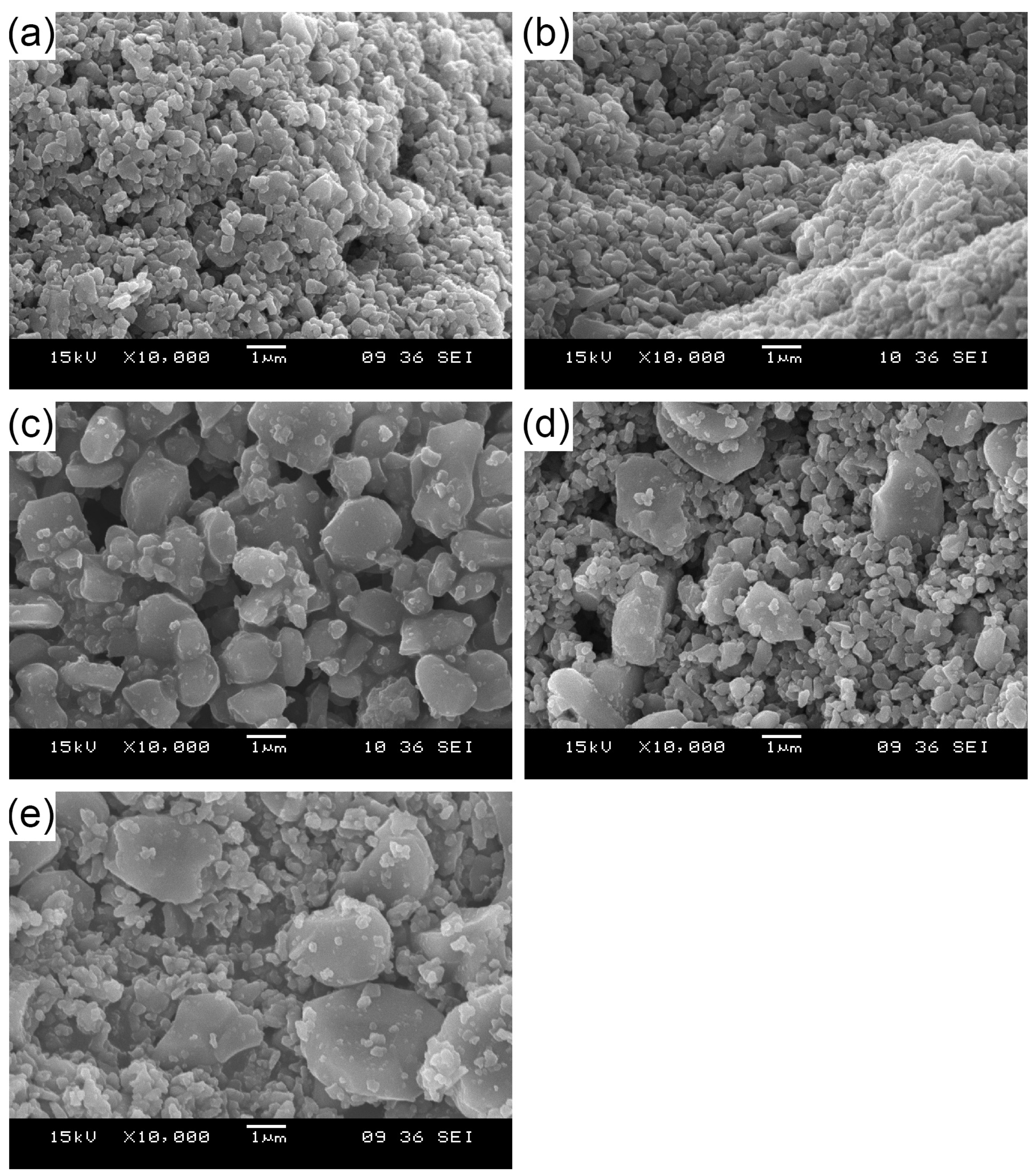
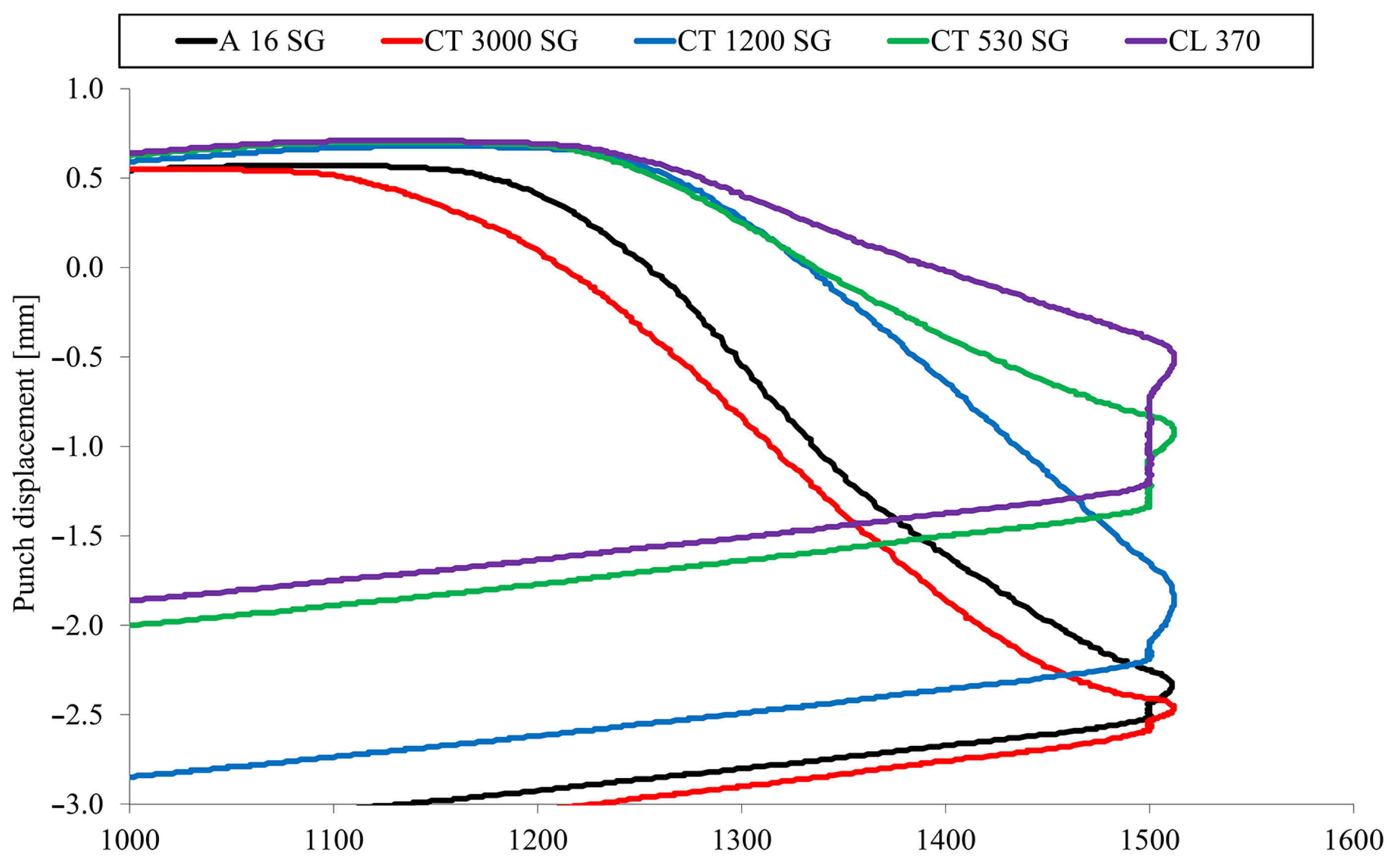
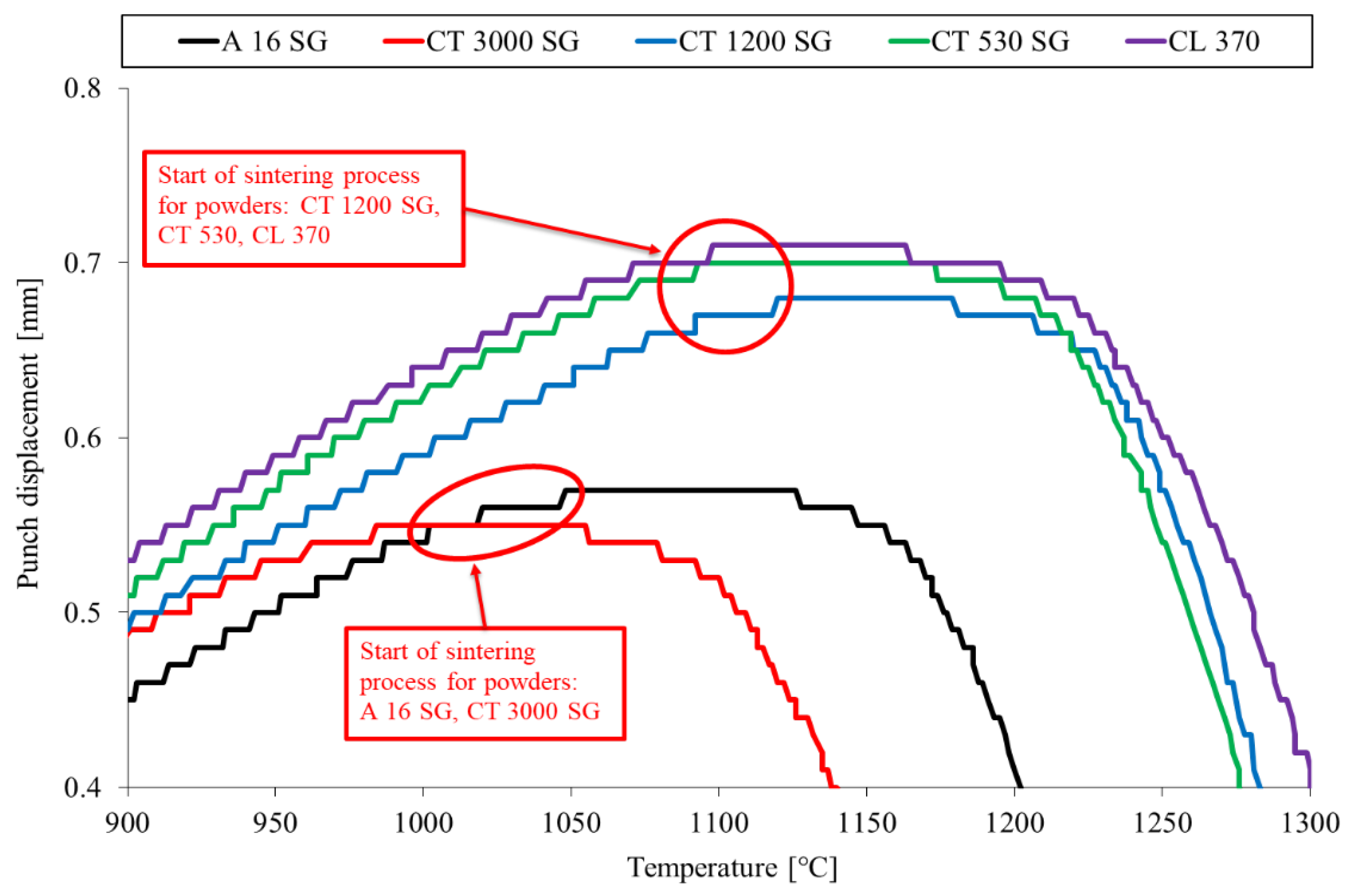
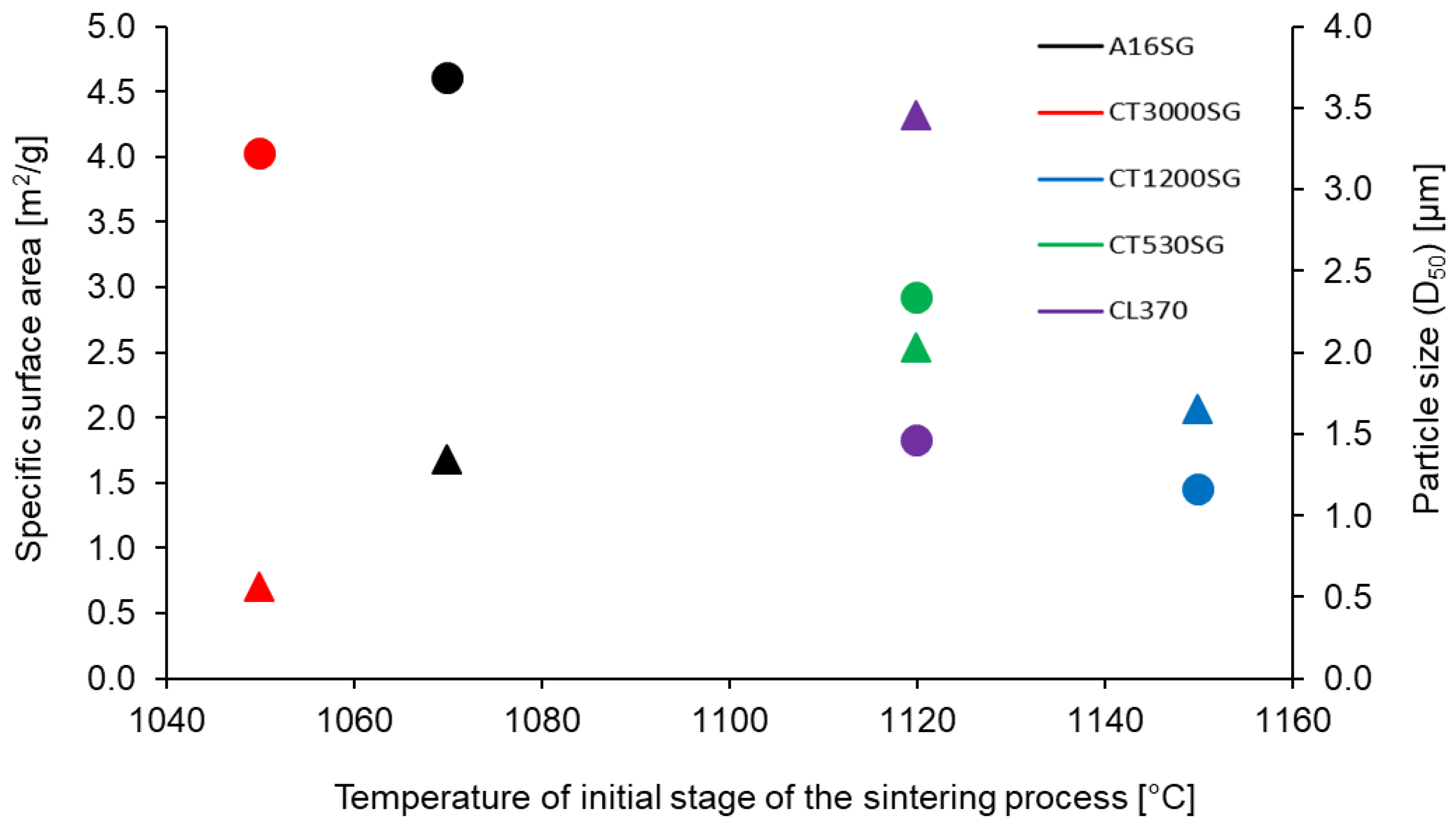

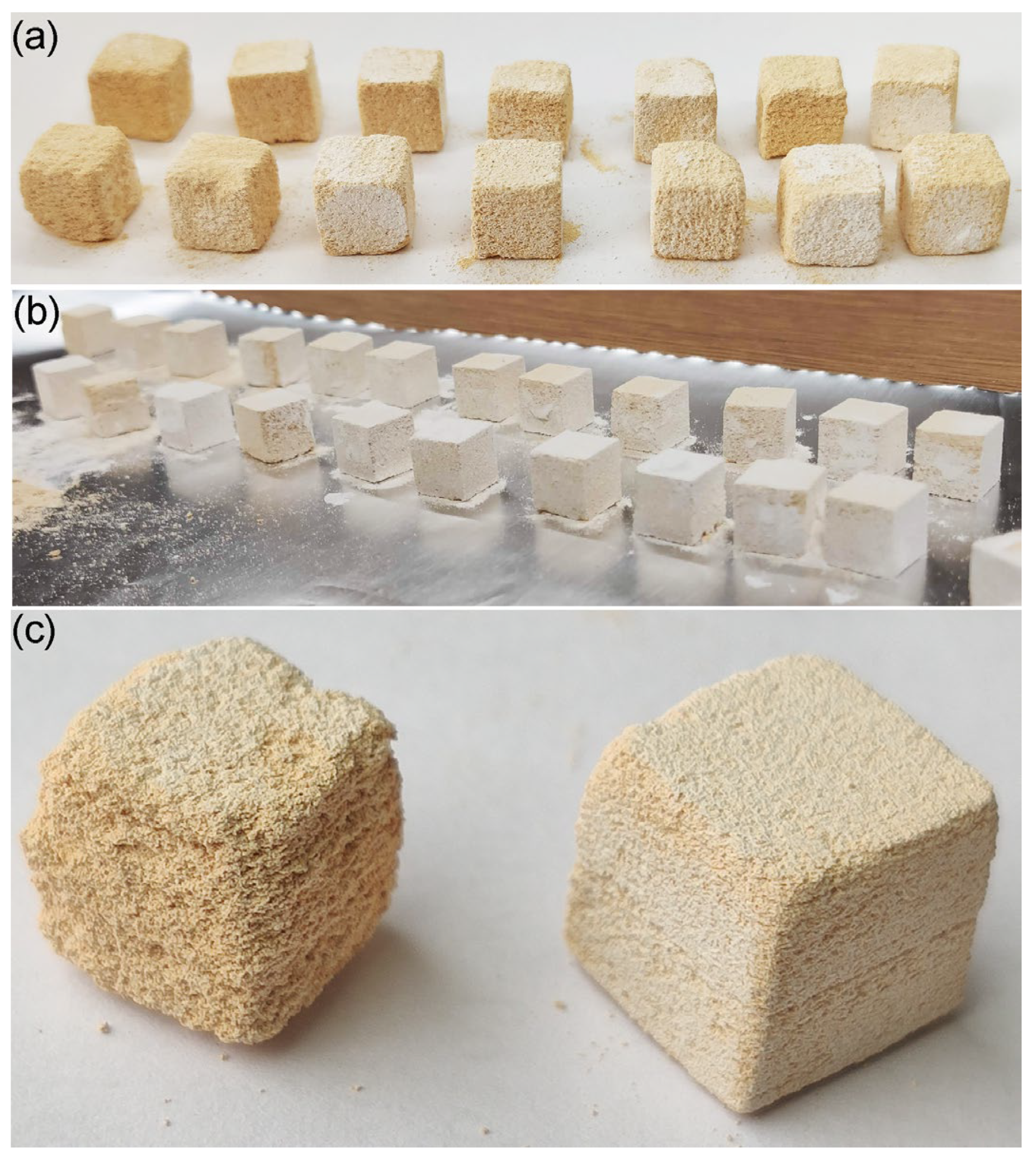
| Powder Grade | ||||||
|---|---|---|---|---|---|---|
| A16SG | CT3000SG | CT1200SG | CT530SG | CL370 | ||
| Chemical composition [%] | Na2O | 0.07 | 0.08 | 0.06 | 0.09 | 0.10 |
| MgO | 0.05 | 0.07 | 0.07 | 0.04 | - | |
| SiO2 | 0.03 | 0.03 | 0.05 | 0.03 | 0.03 | |
| CaO | 0.02 | 0.02 | 0.04 | 0.03 | 0.03 | |
| Fe2O3 | 0.02 | 0.02 | 0.02 | 0.02 | 0.03 | |
| Al2O3 | balance | balance | balance | balance | balance | |
| Powder Grade | ||||||
|---|---|---|---|---|---|---|
| A16SG | CT3000SG | CT1200SG | CT530SG | CL370 | ||
| The particles size distribution | D(3,2) [µm] | 0.634 | 0.459 | 1.550 | 0.707 | 1.086 |
| D(4,3) [µm] | 5.840 | 1.865 | 2.049 | 3.351 | 4.518 | |
| D10 [µm] | 0.236 | 0.216 | 0.945 | 0.241 | 0.490 | |
| D50 [µm] | 1.340 | 0.560 | 1.652 | 2.023 | 3.448 | |
| D90 [µm] | 19.640 | 4.816 | 3.435 | 7.515 | 9.552 | |
| Moda [µm] | 0.326 | 0.326 | 1.451 | 2.787 | 4.444 | |
| Span (D90–D10)/D50 | 14.481 | 8.214 | 1.507 | 3.596 | 2.628 | |
| Specific surface area [m2/g]—BET | 9.298 | 8.477 | 3.403 | 4.619 | 2.913 | |
| Specific surface area [m2/g]—BJH | 9.233 | 8.698 | 3.573 | 4.983 | 3.057 | |
| Pore volume [cm3/g] | 0.019 | 0.017 | 0.006 | 0.008 | 0.005 | |
| Pore average diameter [nm] | 8.338 | 8.180 | 7.435 | 7.258 | 7.217 | |
| Powder Grade | |||||
|---|---|---|---|---|---|
| A16SG | CT3000SG | CT1200SG | CT530SG | CL370 | |
| Density [g/cm3] | 3.95 | 3.96 | 3.96 | 3.96 | 3.95 |
| Young modulus [GPa] | 380 | 385 | 389 | 390 | 386 |
| Powder Grade | ||||||
|---|---|---|---|---|---|---|
| A16SG | CT3000SG | CT1200SG | CT530SG | CL370 | ||
| Percentage depending on the screen size used | >1000 [µm] | 0.92 | 0.75 | 0.65 | 1.35 | 1.85 |
| 1000–600 [µm] | 13.20 | 10.20 | 12.55 | 10.02 | 11.10 | |
| 600–500 [µm] | 5.30 | 14.55 | 18.95 | 6.45 | 6.60 | |
| 500–250 [µm] | 53.45 | 41.35 | 37.80 | 50.35 | 52.15 | |
| 250–100 [µm] | 22.50 | 28.95 | 22.75 | 25.00 | 23.50 | |
| <100 [µm] | 4.63 | 4.20 | 7.30 | 6.55 | 4.80 | |
Disclaimer/Publisher’s Note: The statements, opinions and data contained in all publications are solely those of the individual author(s) and contributor(s) and not of MDPI and/or the editor(s). MDPI and/or the editor(s) disclaim responsibility for any injury to people or property resulting from any ideas, methods, instructions or products referred to in the content. |
© 2023 by the authors. Licensee MDPI, Basel, Switzerland. This article is an open access article distributed under the terms and conditions of the Creative Commons Attribution (CC BY) license (https://creativecommons.org/licenses/by/4.0/).
Share and Cite
Kwiatkowski, M.; Marczyk, J.; Putyra, P.; Kwiatkowski, M.; Przybyła, S.; Hebda, M. Influence of Alumina Grade on Sintering Properties and Possible Application in Binder Jetting Additive Technology. Materials 2023, 16, 3853. https://doi.org/10.3390/ma16103853
Kwiatkowski M, Marczyk J, Putyra P, Kwiatkowski M, Przybyła S, Hebda M. Influence of Alumina Grade on Sintering Properties and Possible Application in Binder Jetting Additive Technology. Materials. 2023; 16(10):3853. https://doi.org/10.3390/ma16103853
Chicago/Turabian StyleKwiatkowski, Maciej, Joanna Marczyk, Piotr Putyra, Michał Kwiatkowski, Szymon Przybyła, and Marek Hebda. 2023. "Influence of Alumina Grade on Sintering Properties and Possible Application in Binder Jetting Additive Technology" Materials 16, no. 10: 3853. https://doi.org/10.3390/ma16103853
APA StyleKwiatkowski, M., Marczyk, J., Putyra, P., Kwiatkowski, M., Przybyła, S., & Hebda, M. (2023). Influence of Alumina Grade on Sintering Properties and Possible Application in Binder Jetting Additive Technology. Materials, 16(10), 3853. https://doi.org/10.3390/ma16103853





